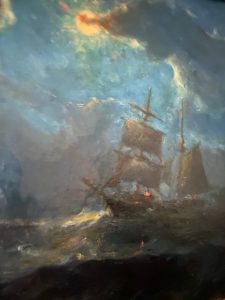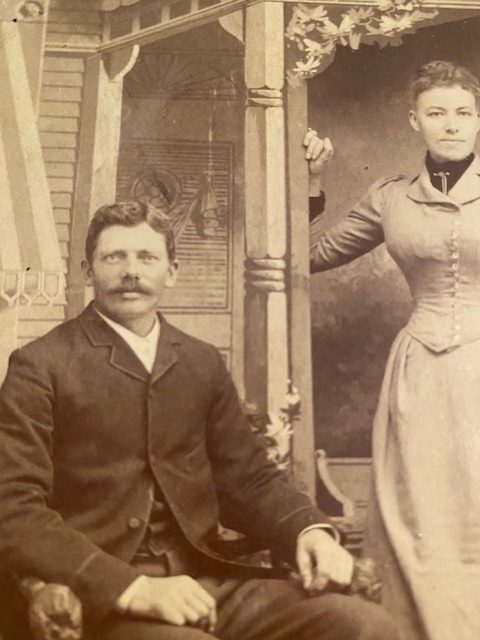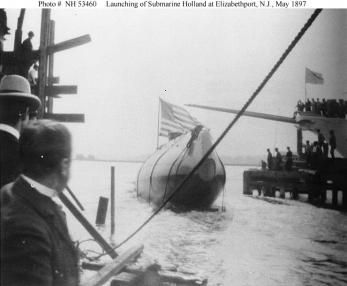Reading over documents and written family stories, I have seen an evolution in the spelling of Carl Anderson’s name: Karl Andersen (Norway), Carl Andersen (1901) and Carl Anderson (1930). I don’t know why he changed the spelling of his name. My Uncle, Ernest Andersen, thought it may have been to “Americanize” it. In its wake, some of Karl’s grandchildren go by “Anderson” and others “Andersen.” “Anderson” usually indicates a person of Swedish descent, not Norwegian.
Karl Andersen (Carl Anderson) was born on June 23, 1856, in Grimstad, Norway. His father was Anders Kittelsen Hurv (1803-1891). His mother was Anne Torine Schjellufsdotter Messel. She was born in 1814 or 1817. The date of her death is unknown. They married on November 13, 1839, in Froland, Aust-Agder, Norway. Karl was the youngest child. He had two older brothers and a sister. Kittel (or Ketil) Andersen (July 31, 1840/41-1922). Schjelluf Andersen (1843-1940) and Maren Andersdotter Hurv (1846-?). His siblings stayed in Grimstad, Norway. Karl, like the vikings of old, went to sea. 
In 1881 the English census noted he was 2nd Mate on the vessel, La Louisiane out of Southampton, England. He was 25 years old. Around that time he survived a sinking ship in the North Sea. Both Mom (Helen Anderson) and Uncle Ernie (Ernest Andersen) thought that Karl met his future wife, Johanna Hansen, in England. Where and how did they meet? Perhaps during his time in England Karl began to learn how to speak and write in English.
He immigrated to the U.S. in 1888 and became a citizen in 1893. His occupation was a ship’s carpenter. Mother (Helen Anderson) described his sea chest. Carl had carved a sailing ship on the cover. She also said Carl could draw beautifully. Carl Anderson was a friend of John Holland, an Irish engineer who developed the first submarine. Carl worked with Holland at the Crescent Shipyard on the Holland VI (launched May 1897) in Elizabethport, New Jersey, and was probably with him at his New Suffolk, New York submarine base (1899-1905) when they tested the USS Holland in 1900 in Peconic Bay. I live about 10 miles from New Suffolk and visited the site of the former facility. Nothing remains but the view and a commemorative sign. I read somewhere that they considered Greenport as a building site, but for some reason went to New Suffolk instead.
Carl Anderson was 34 years old when he married Johanna Maria (or Marie) Hansen, 26, on October 27, 1890, in Elizabeth, New Jersey. The bride had recently arrived from England. Johanna’s mother was Ingeborg (or Enailborg) Oline Jensen. Her father was Hans Hansen. He was Danish, her mother was Norwegian. Both Mom and Uncle Ernie described her as a “distinguished” woman. She enjoyed afternoon teas. Born in Norway, she worked in the court of Queen Victoria as a seamstress or lady-in-waiting. (I’ve heard both versions.)
When they married, they lived at 131 Broadway in Elizabeth. In the 1900 census, Carl Anderson, 43, Johanna Anderson, 36, and their son, Clarence, 6, lived at 13 Atlantic Street in Elizabeth. Three boarders also lived with them: Jonas Petersen, 25, Oscar Hansen, 22 and Martin Hansen, 12. Were they shipmates? Relatives from Norway? Recent immigrants needing a roof over their heads? From reading census records it appears quite common for people to take in boarders.

Carl and Johanna immediately tried to start a family. Their first daughter, Florence T. Anderson, was born on July 22, 1891. She died two months later on September 21, 1891. The next baby, another Florence T. was born prematurely. She lived 12 days, and was buried on June 3, 1892, in grave #473, Map 2. A third daughter, Florence, was born in January 1893. She lived for 11 months, 21 days. She died of pneumonia and was interred on January 30, 1894, in Public Ground 2, Grave 148, Row 3. The undertaker was M. Durming. At that time her mother was seven months pregnant with another child. There is no record of where the babies were buried, but I think it might be Evergreen Cemetery in Hillside, New Jersey. Clarence Anderson, the first son and child to live to adulthood, was born on March 21, 1894. Clarence is an English, not a Norwegian name. There is no story or note on why they choose his name. Perhaps it had some meaning to them from their time in England.
Carl donated the family silver (Johanna’s?) at the request of a lawyer friend for a museum. Uncle Ernie said some of the pieces dated back to the 16th century and included the family crest. Mom’s mother, Clarence’s wife, kept some of the family silver wrapped in flannel in Carl Anderson’s sea chest. Mom thought that eventually her father sold the silver. I wish there was a photo of the chest.
One of Carl’s close friends was Dr. William A. M. Mack, mayor of Elizabeth. He was about his age, and elected mayor of Elizabeth in 1898. Dr. Mack delivered his son, Clarence. I believe Carl and Johanna were part of the group with Dr. Mack when he dedicated the Civil War Parrott rifles (cannons) in the Civil War section of Evergreen Cemetery. This Memorial Day event – May 30, 1900 – followed a parade up Broad Street. Less than a year later Johanna died and was buried near the Civil War section. Dr. Mack died several months before her in January 1901. Mack is also buried in Evergreen Cemetery. A statue of him was dedicated in 1902, and can be found in Liberty Square, the Frog Hollow section of Elizabeth. I wonder what Carl thought and felt when he looked at the statue. I’m he felt sure sadness, that a good time in his life was over.
Johanna Anderson died in childbirth the morning of May 8, 1901. The cause of death was eclampsia. A stillborn daughter, Florence, was buried with her. They were interred in Evergreen Cemetery on May 10, 1901. Father and son were alone to mourn. Who was the “Florence” Johanna and Carl kept naming their baby girls after? Clarence Anderson named his first daughter, Florence.

After his wife’s death, Carl went back to the sea. Mom and Uncle Ernie both said Carl had gotten his Master’s papers (ship’s captain). He may have owned a share in one or two vessels. Uncle Ernie said that he was in the import/export business. Mom told me that he imported King Oscar sardines. I was reminded of the story every time she had a King Oscar sardine sandwich. (I never badgered her for a bite!). I don’t have any evidence, but I feel that Carl did return to Norway on several of his trips.
Carl Anderson sailed around Cape Horn several times. He would go to sea for long periods, several months or many months. After his wife died, the story goes, he sent to Norway for a housekeeper who could take care of his son, Clarence. Her name was Lena (Tina) Holst. She was in her early 40s and a widow. Lena Holst became a citizen in 1901. Her 15-year-old son, Einar Holst, remained in Norway until 1907 when he came to the U.S. The 1920 Census shows Lena and Einar Holst living with Carl Anderson in Elizabeth. Mom said that Mrs. Holst was Carl Anderson’s “concubine.”
Horror stories begin after Lena Holst’s arrival. Clarence was abused, beaten, left outside in the winter, and fed by neighbors. The young boy was probably traumatized by his mother’s death and father’s disappearance. Lena Holst may have been cruel, harsh, or just lacking in compassion. I’m sure that this brutal treatment was partly responsible for Clarence’s alcoholism and physical abuse of his wife and children. Clarence married Anna Paloske when he was 22 years old and escaped his father’s house and the Holsts. There are no stories of what Carl Anderson thought of his son and his upbringing or what his son thought of him. Clarence named his first son, Carl, after his father. When Carl and his sister, Florence, were born, Carl gave each of them a sterling silver spoon, fork, and cup set.
Carl’s nieces and nephew from his older brother, Kittel, joined him in America. Maren Andersen married Fred Jacobson. Her son, Lars, drew the Hurv family chart. Anna Andersen married twice—first to Jens Sand and then to a man named Hansen. Anders Andersen and his wife lived a few blocks away from Carl and Johanna on Atlantic Street in Elizabeth. Katinka Andersen decided to return to Grimstad. She lived there until she died in 1966. I don’t know the relationships among the cousins. I never heard of them until I started worked on the Norwegian side of the family. Uncle Dave (David Anderson) has a letter to his father, Clarence, from one of the Sands who lived in South Dakota asking how he was doing and to get in touch.
Carl Anderson died on September 16 or 17, 1930, of myocardial degeneration. Mom said he had heart trouble. He was 74. He was living with Lena Holst at 13 Atlantic Street in Elizabeth. Mom remembered visiting him before he died. He was lying in a very large four-poster bed with heavy drapes enclosing it.
Carl must have been ill for a few years before his death. He drafted a will on August 29, 1929, when he was in Elizabeth General Hospital. He left everything to his son, Clarence Anderson, with one provision: “It is my desire, that, in consideration of this bequest, that my son, Clarence Anderson, shall permit Mrs. Lena Holst, my friend and housekeeper, to occupy the front room of my house at No. 13 Atlantic Street, Elizabeth, NJ, without any cost or charge to her, so long as she desire to do so, and if my son Clarence Anderson shall sell this house, that he shall furnish her with a room of equal comfort in some other place that shall be suitable to Mrs. Lena Holst.” Uncle Ernie thought that he was buried in Evergreen Cemetery in Hillside, NJ. Mom had a note that indicated he was buried in Rosedale Cemetery in Linden, NJ, in Grave 74, Row 5, Single Plot, 6 APS. His funeral was handled by August F. Schmidt Funeral Home in Elizabeth. My cousin, Donna, confirmed that he is buried in Evergreen Cemetery in Hillside, N.J. His grave is located on Row #5, Map #6, near a building by the Newark corner. He was buried on September 20, 1930.
After Carl Anderson died, Clarence and his family moved into 13 Atlantic Street. Mom recalled bringing Mrs. Holst some soup to eat. She lived in an upstairs room or the attic. Clarence Anderson sold the house after his wife died in 1937. I was curious about what happened to Mrs. Holsts, given her probable strained relationship with Clarence. She appears in the 1940 Census as an 80-year-old boarder with the Frederick family on 848 Livingston Street in Elizabeth. There is no mention of her son, Einar. After that Lena Holst disappears.
Who was Carl Anderson? Based on the events of his life, here’s my guess: 
Carl was rugged and tough from living out at sea. He was an outgoing man, making friends of people well beyond his own upbringing in Norway. As a ship’s carpenter, he had to be resourceful and inventive. He was comfortable with different kinds of people—sailors, builders, mayors. I believe that he loved his wife, Johanna, and mourned her loss. He was loyal to Lena, his friend, housekeeper, and lover of 30 years. He loved his son, but I don’t know how much love he showed him. What I like most about Carl is the way way he thrust himself into the world and experienced everything. But what is most endearing is his love of Buffalo Bill and his Wild West Show! Seeing the Rough Riders, and the Sioux warriors, and the dust and commotion and battles on the plains must have thrilled the man and boy in him who only knew a coastal village growing up. A souvenir picture he had of Buffalo Bill was one of his treasured possessions; and now it is one of mine.
